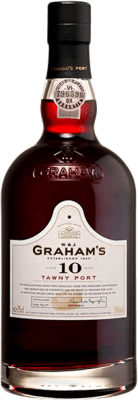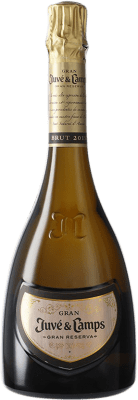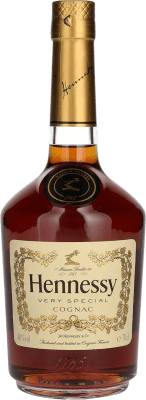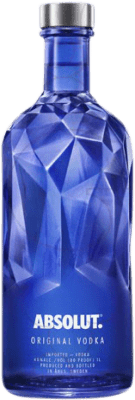Château Saint Cosme Gigondas Aged 75 cl. Origin.
Producer.
Variety.
![]() Syrah, Grenache, Mourvèdre, Cinsault.
Syrah, Grenache, Mourvèdre, Cinsault.
Country of origin.
Region of origin.
Appellation of origin.
(UE)401/2010 Certification.
Appellation d'Origine Contrôlée (A.O.C.)
A.O.C. Gigondas.
Production region.
The production region of A.O.C. Gigondas is located in Exclusivamente la comuna de Gigondas, en Vaucluse, región vinícola del sur del Ródano, Francia. Es principalmente una región de vino tinto, con una cantidad muy pequeña de vino rosado producido. Ningún vino blanco tiene la denominación de Gigondas. Siendo un hermano pequeño de Châteauneuf-du-Pape, el vino es moderadamente prestigioso y puede envejecer bien cuando se lo trata con cuidado.
Weight.
1.500 gr. (1,5 Kg.).
Producer |
|
Variety |
|
Country of origin |
|
Region of origin |
|
Appellation of origin |
|
(UE)401/2010 Certification |
Appellation d'Origine Contrôlée (A.O.C.) |
Production region |
The production region of A.O.C. Gigondas is located in Exclusivamente la comuna de Gigondas, en Vaucluse, región vinícola del sur del Ródano, Francia. Es principalmente una región de vino tinto, con una cantidad muy pequeña de vino rosado producido. Ningún vino blanco tiene la denominación de Gigondas. Siendo un hermano pequeño de Châteauneuf-du-Pape, el vino es moderadamente prestigioso y puede envejecer bien cuando se lo trata con cuidado. |
Weight |
1.500 gr. (1,5 Kg.). |
Château Saint Cosme Gigondas Aged 75 cl. Data sheet.
Typology.
Variety.
![]() Syrah, Grenache, Mourvèdre, Cinsault.
Syrah, Grenache, Mourvèdre, Cinsault.
Vintage / Harvest.
Ageing.
Format.
Bottle.
Capacity.
75 cl.
Alcohol content.
14% Vol.
Weight.
1.500 gr. (1,5 Kg.).
Visual tasting note.
Abundant tear, Intense red, Reddish core, Bluish red trim.
Olfactory tasting note.
Blackberry jam, Black liquorice, Striking, Hints of spices.
Tasting note.
Sweet, Pepper notes, End a bit closed.
Recommended pairing.
Olives, Goat cheeses, Pink meats.
Consumption temperature.
4ºC - 6ºC.
Consumption.
It is recommended to drink in moderation and demonstrate a responsible consumption of alcoholic beverages.
Typology |
|
Variety |
|
Vintage / Harvest |
Currently marketed by the producer. |
Ageing |
|
Format |
Bottle. |
Capacity |
75 cl. |
Alcohol content |
14% Vol. |
Weight |
1.500 gr. (1,5 Kg.). |
Visual tasting note |
Abundant tear, Intense red, Reddish core, Bluish red trim. |
Olfactory tasting note |
Blackberry jam, Black liquorice, Striking, Hints of spices. |
Tasting note |
Sweet, Pepper notes, End a bit closed. |
Recommended pairing |
Olives, Goat cheeses, Pink meats. |
Consumption temperature |
4ºC - 6ºC. |
Consumption |
It is recommended to drink in moderation and demonstrate a responsible consumption of alcoholic beverages. |
Château Saint Cosme Gigondas Aged 75 cl. Description.
Parker TWA Score.
90 Points.
Product reference.
WAN4553279
Accessories.
This product is provided in the conditions and format in which it is marketed at the current time. In cases where the product includes an additional packaging, box and/or case, These accessories will be included in the shipment as long as they comply with the dimensions of the special packaging adapted and approved for the transport of beverages.
In general, the images of the products that we publish on our website are only relevant for graphic purposes. The images do not show other accessories such as additional packaging (box, case, etc.) or promotional elements that may occasionally be included by the manufacturer along with the product. If you wish, we can inform you about the additional packaging, elements and accessories included with the product at the current time.
Weight.
1.500 gr. (1,5 Kg.).
Actual price.
35,95 € . This product is currently not available.
Storage position.
Lateral position, horizontal bottle.
Storage temperature.
Store at a constant temperature between 10-17ºC.
Humidity should be constant around 60-80%.
Recommendations.
Keep preferably away from light.
Parker TWA Score |
90 Points. |
Product reference |
WAN4553279 |
Accessories |
This product is provided in the conditions and format in which it is marketed at the current time. In cases where the product includes an additional packaging, box and/or case, These accessories will be included in the shipment as long as they comply with the dimensions of the special packaging adapted and approved for the transport of beverages. |
Weight |
1.500 gr. (1,5 Kg.). |
Actual price |
35,95 € . This product is currently not available. |
Storage position |
Lateral position, horizontal bottle. |
Storage temperature |
Store at a constant temperature between 10-17ºC. |
Recommendations |
Keep preferably away from light. |
Château Saint Cosme Gigondas Aged 75 cl. Legal notice.
Please keep in mind.
The information provided and referred to the product features and details has been provided by the expert, manufacturer or producer or published on the official sites. In no case can it be considered as assessment made by our team, unless expressly stated otherwise.
We suggest you to refer to the comments and reviews posted by our customers and users to expand and contrast this information.
Misreading.
Our team provides this information and details in ESPAÑOL language.
If you browse in another language note that the information contained may have been translated from the original language through an automated real-time process that has not been supervised by our human team.
In case of doubt, misunderstanding or misreading about the content of this information you should refer to the original version of this page or contact our customer service team.
Product image.
The product image or its label is only relevant for graphic purposes, so it may not match the identification of the vintage or other features and details of the product for sale. This product is provided in the conditions and format in which it is marketed at the current time.
This product is not identified or supplied in a specific vintage. The product image and label may not match the vintage identification or other characteristics and details of the product for sale.
Accessories.
This product is provided in the conditions and format in which it is marketed at the current time. In cases where the product includes an additional packaging, box and/or case, These accessories will be included in the shipment as long as they comply with the dimensions of the special packaging adapted and approved for the transport of beverages.
In general, the images of the products that we publish on our website are only relevant for graphic purposes. The images do not show other accessories such as additional packaging (box, case, etc.) or promotional elements that may occasionally be included by the manufacturer along with the product. If you wish, we can inform you about the additional packaging, elements and accessories included with the product at the current time.
Country of origin.
Spain. This product is shipped from Spain.
Legal Notice.
It is against the law to sell or supply alcohol to, or to obtain alcohol on behalf of a person under the age of 18 years.
If you are not more than 18 years old, you must leave this website.
Return policy.
Return policy.
Last update: Monday, 22 Jan 2024
For further information: Terms and conditions of the service.
Please keep in mind |
The information provided and referred to the product features and details has been provided by the expert, manufacturer or producer or published on the official sites. In no case can it be considered as assessment made by our team, unless expressly stated otherwise. |
Misreading |
Our team provides this information and details in ESPAÑOL language. |
Product image |
The product image or its label is only relevant for graphic purposes, so it may not match the identification of the vintage or other features and details of the product for sale. This product is provided in the conditions and format in which it is marketed at the current time. |
Accessories |
This product is provided in the conditions and format in which it is marketed at the current time. In cases where the product includes an additional packaging, box and/or case, These accessories will be included in the shipment as long as they comply with the dimensions of the special packaging adapted and approved for the transport of beverages. |
Country of origin |
Spain. This product is shipped from Spain. |
Legal Notice |
It is against the law to sell or supply alcohol to, or to obtain alcohol on behalf of a person under the age of 18 years. |
Return policy |
Return policy. |
No customer reviews at this time. Be the first to post a review!
Château Saint Cosme Gigondas Aged 75 cl.
Additional information.
«Château Saint Cosme Aged Gigondas» is produced by Château Saint Cosme. In the elaboration of «Château Saint Cosme Aged Gigondas» the grape varieties that are used are Syrah, Grenache, Mourvèdre and Cinsault. «Château Saint Cosme Aged Gigondas» is a product from France. The production region of «Château Saint Cosme Aged Gigondas» is Rhône. It is certified with A.O.C. Gigondas. The production region of A.O.C. Gigondas is located in Exclusivamente la comuna de Gigondas, en Vaucluse, región vinícola del sur del Ródano, Francia. Es principalmente una región de vino tinto, con una cantidad muy pequeña de vino rosado producido. Ningún vino blanco tiene la denominación de Gigondas. Siendo un hermano pequeño de Châteauneuf-du-Pape, el vino es moderadamente prestigioso y puede envejecer bien cuando se lo trata con cuidado. The weight of «Château Saint Cosme Aged Gigondas» is 1.500 grams (1,5 Kg.).
«Château Saint Cosme Aged Gigondas» belongs to the Red wine category, Red wine Appellation of origin A.O.C. Gigondas. In the elaboration of «Château Saint Cosme Aged Gigondas» the grape varieties that are used are Syrah, Grenache, Mourvèdre and Cinsault. This product is not identified or supplied in a specific vintage. The product image and label may not match the vintage identification or other characteristics and details of the product for sale. If you wish, we can provide you with this information, and, of course, You can request a specific vintage and we will try our best to satisfy you. The aging of «Château Saint Cosme Aged Gigondas» occurs in two phases: in a barrel and in the bottle. «Château Saint Cosme Aged Gigondas» is a Aged with at least 24 months of aging, of which between 6 and 12 months take place in a barrel and the rest in the bottle, before its commercialization. «Château Saint Cosme Aged Gigondas» is marketed in bottle 75 cl format. The alcohol content of «Château Saint Cosme Aged Gigondas» is 14% Vol. The weight of «Château Saint Cosme Aged Gigondas» is 1.500 grams (1,5 Kg.). Regarding the tasting of «Château Saint Cosme Aged Gigondas», the notes abundant tear, intense red, reddish core and bluish red trim stand out in its visual phase. Among the predominant notes of the olfactory tasting are blackberry jam, black liquorice, striking and hints of spices. Finally, The tasting of «Château Saint Cosme Aged Gigondas» in the taste phase stands out with sweet, pepper notes and end a bit closed. It is recommended to pair «Château Saint Cosme Aged Gigondas» with olives, goat cheeses and pink meats. The optimum temperature to consume «Château Saint Cosme Aged Gigondas» is 4ºC - 6ºC.
The weight of «Château Saint Cosme Aged Gigondas» is 1.500 grams (1,5 Kg.). The final sale price of «Château Saint Cosme Aged Gigondas» is 35,95 € in PrivateCeller.com. Temporarily «Château Saint Cosme Aged Gigondas» is not available for sale on PrivateCeller.com.
The information provided and referred to the product features and details has been provided by the expert, manufacturer or producer or published on the official sites. In no case can it be considered as assessment made by our team, unless expressly stated otherwise. We suggest you to refer to the comments and reviews posted by our customers and users to expand and contrast this information. The product image or its label is only relevant for graphic purposes, so it may not match the identification of the vintage or other features and details of the product for sale. This product is provided in the conditions and format in which it is marketed at the current time. Spain. This product is shipped from Spain.
Variety:
Syrah, Grenache and Cinsault.
Château Saint Cosme Gigondas Aged 75 cl.
Variety Syrah.
See Syrah Red wine list.
 Español [ ES ]
Español [ ES ]Origen.
No hay unanimidad sobre el origen de la uva shirah. Algunos autores sostienen la teoría de que procede de la ciudad persa Shiraz, otros, sin embargo, la sitúan en Siracusa en Sicilia, mientras que otros indican que originaria de la zona francesa del Ródano, donde tiene una penetración y una gran importancia en su viticultura. Lo que sí parece indiscutible es que el origen de esta variedad, desde el punto de vista vitivinícola, debe situarse en el Ródano. Al norte de este río, la tribu gala de los Allobroges cultivaba ya en tiempos del Imperio Romano una uva que crecía de manera asilvestrada en los alrededores y que llamaron allobrógica; parece ser que con el tiempo esta uva evolucionó hasta llegar a ser la cepa que todos conocemos hoy como syrah. El escocés James Busby llevó esquejes de varias uvas a Australia en 1832 y la syrah fue la que mejor se adaptó a las condiciones climatológicas de Oceanía. Cuando en los años noventa los vinos del Ródano empezaron a popularizarse, en Australia se dieron cuenta de que tenían un tesoro.
Características.
Las cepas de la variedad syrah son muy vigorosas, de porte erguido o semierguido con sarmientos muy largos, delgados, delicados y con muchos hijuelos. Su desborre es de media estación a tardío y maduración precoz. Los racimos de la variedad syrah son de tamaño medio, compactos cilíndrico-alargados, con pedúnculo largo y poco lignificado. En ocasiones con una primera ramificación pedunculada y separada del resto del racimo. Con tamaño de bayas muy uniforme, estas son de tamaño pequeño a medio, de forma ligeramente elíptica, aunque en algunos materiales esta característica apenas es visible excepto en las racimas. Su piel es negro azulada y cicatriz estilar muy marcada, muy abundante en pruina, hollejo grueso y resistente y muy difícil de desprender de su pedúnculo. La pulpa no tiene pigmentación, es consistente y de jugosidad limitada. La uva syrah también es conocida como como shiraz, sirah, sérine, candive, hignin, sirac, syra, biaune, balsamia. Es una variedad que se adapta bien a todo tipo de suelos, siempre que no tengan excesos de humedad. El viento produce bastantes daños en esta cepa si sus sarmientos no están bien tutorados y sujetos, se recomienda utilizar espalderas altas. Es muy sensible a la eutipiosis, a la sequía y a la clorosis férrica, así como a los ácaros. Sensible al mildiu y al black rot, a la polilla del racimo, a la fitotoxicidad por herbicidas, especialmente al diurón. Es poco sensible al oídio al principio de su brotación, pero su sensibilidad aumenta a partir de la cierna. Tolera bastante bien la botritis, pero cuando la maduración es excesiva puede verse afectada por ella. No suele verse afectada por corrimiento de racimo. No es una cepa que requiera de altos niveles de magnesio pero sí de nitrógeno, fósforo y potasio. Sus injertos deben hacerse sobre portainjertos que resistan bien la clorosis férrica. Se puede realizar la poda en pulgares cortos o en Guyot y se desaconseja despuntarla.
Zonas de cultivo.
Hoy en día podemos encontrar la variedad syrah en toda Europa, pero también en Australia, Argentina, Chile, Sudáfrica y California. En España el cultivo de la variedad syrah se extiende prácticamente por toda su geografía, siendo recomendada su plantación en las Denominaciones de Origen en Cataluña, Extremadura, Comunidad Valenciana, Andalucía, Aragón, Asturias, Baleares, Canarias, Cantabria, Castilla-La Mancha, Comunidad de Madrid, Navarra, Murcia, viña syrah.
Vinos.
La uva shyrah produce vinos de buena calidad, amables y sabrosos, con un alto grado alcohólico. Los tintos shyrah tienen mucho color y cuerpo, por tener gran cantidad de extracto seco. Son opulentos, vigorosos, potentes, de textura sedosa, con cuerpo, gran cantidad de taninos y materias colorantes, un característico aroma a violeta y cassis, y ligeros toques ahumados. Tienen una gran capacidad de envejecimiento donde mantienen bastante bien su color y no adquieren exceso aroma a madera, aunque sí tienen toques de cuero, alquitrán y ahumado, y ligeramente a vainilla. Es un vino con una capa oscura muy cubierta, con intensidad, aromático, un vino que ha adquirido mucha fama a nivel mundial. En nariz aromas a fruta madura, recordando a las grosellas, las violetas, las moras silvestres y a las frambuesas, manteniendo aromas a pimiento o canela y clavo. El color es intenso, refinado, sólido y austero, especiado y de acidez destacable.El vino syrah se utiliza mucho en coupages con Cabernet Sauvignon y Merlot.
Variety Grenache.
See Grenache Red wine list.
 Español [ ES ]
Español [ ES ]Origen.
El origen de la uva garnacha está localizado, según se ha comprobado ampelográficamente, en la región de Aragón, en el noreste de España. Desde allí fueron llevados a otros territorios de la Corona de Aragón, como Cerdeña o el Rosellón, en el sur de Francia. Uno de los primeros nombres que recibió fue "tinto aragonés”. En Cerdeña se conoce como cannonau, donde se afirma que se originó allí y que se extendió a otras tierras del Mediterráneo que estaban bajo el gobierno de Aragón. La garnacha ya estaba bien difundida a ambos lados del Pirineo cuando la región de Rosellón fue anexionada por Francia. A partir de ahí la vid se abrió camino a través de Languedoc y al sur de la región del Ródano, donde quedó bien asentada en el siglo XIX. A pesar de su preponderancia en las cercanas regiones de Navarra y Cataluña, la garnacha no fue plantada ampliamente en La Rioja hasta principios del siglo XX, cuando se replantaron los viñedos después de la epidemia de filoxera. Australia comenzó a plantar cepas de garnacha en el siglo XVIII, convirtiéndose en la variedad de uva de vino tinto más plantada del país hasta que fue superada por la syrah a mediados de los años sesenta. En el siglo XIX, los viticultores de California apreciaron la capacidad de la vid para producir altos rendimientos y soportar el calor y la sequía.
Características.
La variedad garnacha crece en cepas muy vigorosas de porte erguido, con elevada fertilidad y muy productivas. Los racimos son entre medianos y grandes, muy compactos y de bayas bastante uniformes, con pedúnculo corto. Las bayas son medianas de tamaño, esféricas, con epidermis de color rojo violeta oscuro, de difícil desprendimiento de su pedicelo. Su hollejo es fino, muy sensible a roces y con mucha pruina. La consistencia de su pulpa es blanda, muy jugosa, sin pigmentación. La garnacha tinta es una variedad muy sensible al mildiu tanto en hojas como en racimos, al black rot, a la excoriosis y a la yesca. Resiste muy bien al oídio, pero no al oídio tardío. Es muy sensible a distintos tipos de corrimientos ya sean fisiológicos, por frio, o inducidos por determinados patrones como Rupestris de Lot. Se ve bastante afectada por la polilla del racimo y los cicadélidos. Sensible a la necrosis bacteriana y a los virus del amarillo y bandeado de nervios, así como al desecado del raquis y por ello con altos requerimiento en magnesio. Su sensibilidad a la botritis y a la podredumbre ácida es media. No tolera bien los suelos muy húmedos o encharcados. Las cepas de garnacha son algo sensibles al corrimiento y poco a la eutipiosis y a los ácaros. Son cepas que resisten muy bien el viento y la sequía, adaptándose a cualquier tipo de suelo. Sus podas han de ser cortas, dando buenas producciones y de calidad al disponerse en espalderas, pero producciones excesivas reducen el color y minimiza su contenido en azúcar y pierde aroma. También es exigente en fósforo y boro. Poco exigente en nitrógeno.
Zonas de cultivo.
La garnacha está muy presente en todo el mundo, destacando Francia y España, aunque desde finales del siglo XX la superficie plantada ha ido decreciendo debido a que se han puesto de moda otras viñas como tempranillo, cabernet Sauvignon y merlot. En España es común en Borja y Cariñena, ambas en Aragón. Se usa en las zonas de Denominación de Origen Calificada de la Rioja y Priorato, además de en las áreas montañosas al suroeste de Madrid, al norte de la provincia de Toledo (D.O. Méntrida) y en Cebreros (Ávila). Otras regiones vitícolas con considerables plantaciones de garnacha incluyen Costers del Segre, L'Empordá-Costa Brava, La Mancha, Madrid, Penedés, Somontano, Tarragona, Terra Alta. Es una variedad recomendada en las comunidades autónomas de Aragón, Castilla-La Mancha, Castilla y León, Cataluña, Extremadura, Madrid, País Vasco y Comunidad Valenciana y otras con menor presencia. Es la uva protagonista de una gran mayoría de los vinos rosados de la D.O. Navarra. También se elaboran vinos de esta variedad, ya sea monovarietal o coupage, en Francia, Italia, Australia y EE.UU y en menor medida, en Mexico, chile, Uruguay, Argentina y Sudáfrica.
Vinos.
La garnacha es una uva que se utiliza, en muchas zonas, para mejorar el color y la graduación alcohólica de vinos de otras variedades. Los Los vinos jóvenes de garnacha tienen aromas de pimienta recién molida pero manteniendo aromas de frambuesa y moras. Al envejecer, con poca crianza en barricas de roble, los vinos mantienen su color potente, adquieren aromas a fruta madura, manzana y toques minerales, sobre todo los procedentes del Priorato. Son vinos de grado alcohólico elevado, afrutados, redondos y amables, con gran intensidad aromática (frutas negras muy maduras, ciruelas secas) y con buena capacidad de crianza.
Variety Cinsault.
See Cinsault Red wine list.
 Español [ ES ]
Español [ ES ]Origen.
La cinsaut o cinsault es una uva tinta importante en la región francesa de Languedoc-Rosellón y en las antiguas colonias francesas de Argelia y Marruecos. Se mezcla a menudo con uvas como la garnacha y la cariñena para añadirle a los vinos suavidad y buqué. Tiene algunos sinónimos, de los cuales el más se presta a la confusión es el de oeillade, aunque es diferente de la oeillade original, que ya no se cultiva. En Sudáfrica era conocida como hermitage, de ahí que el cruce con cinsault y pinot noir se conoce como pinotage, su cruce más famoso. La cinsault parece ser una variedad antigua que puede haberse originado en Hérault, pero podría haber sido traída por comerciantes del Mediterráneo Oriental.
Características.
La vid de variedad cinsault puede producir cosechas abundantes, pero los vinos son mucho mejores si se controlan los rendimientos. La cinsaut es muy resistente a la sequía, pero puede ser susceptible a enfermedades, de modo que aprecia un clima seco. Produce racimos grandes y cilíndricos de uvas oscuras con pieles gruesas.
Cultivo.
La cinsault es la cuarta uva tinta más plantada de Francia, y es especialmente importante en la región de Languedoc-Rosellón. También es usada ampliamente para hacer vinos rosados en la Provenza. En Argelia, debido a su gran resistencia a la sequía se usa para hacer grandes volúmenes de vino así como en Marruecos y Túnez. En Australia crece bajo una gran variedad de nombres, como black prince, blue imperial, oeillade y ulliade. En Chile se le conoce como cinsault o cargadora, dada la abundancia de racimos. En total Chile cuenta con más de 796 hectáreas plantadas de cinsault, de las cuales casi 700 se concentran en el Valle del Itata, en las zonas de Coelemu, Guarilihue y Portezuelo. Actualmente en otras zonas vitivinícolas como el Valle de Colchagua y Villarrica, se han iniciado nuevas plantaciones. En Italia se la conoce como ottavianello. Hay una pequeña Denominazione di Origine Controllata (DOC) dedicada a la cinsaut, la Ottavianello di Ostu, con una producción de menos de 100 cajas al año. En cualquier caso, la cinsault es muy usda en las mezclas de Apulia y también está recabando la atención de los productores interesados en reavivar las variedades más antiguas. La cinsault es un componente importante en el ensamblaje del Château Musar libanés. En Sudáfrica crece mucha cinsaut, buena parte de la cual es mezclada con cabernet sauvignon. El viñedo más antiguo de cinsault puede ser el de Bechtold en Lodi, California, Estados Unidos, que fue plantado en 1885 por Joseph Spenker. Se planta también algo de cinsaut en California donde se le da el nombre de black malvoisie. También hay plantaciones de cinsaut en el valle Yakima del estado de Washington.
Data sheet.
Château Saint Cosme Gigondas Aged 75 cl.
Red wine. Château Saint Cosme. Aged. A.O.C. Gigondas. Rhône. France. Syrah, Grenache, Mourvèdre, Cinsault. 75 cl..
Variety.
![]() Syrah, Grenache, Mourvèdre, Cinsault.
Syrah, Grenache, Mourvèdre, Cinsault.
Country of origin.
Region of origin.
Appellation of origin.
Vintage / Harvest.
Ageing.
Format.
Bottle.
Capacity.
75 cl.
Alcohol content.
14% Vol.
Parker TWA Score.
90 Points.
Visual tasting note.
Abundant tear, Intense red, Reddish core, Bluish red trim.
Olfactory tasting note.
Blackberry jam, Black liquorice, Striking, Hints of spices.
Tasting note.
Sweet, Pepper notes, End a bit closed.
Recommended pairing.
Olives, Goat cheeses, Pink meats.
Consumption temperature.
4ºC - 6ºC.
Typology.
Producer.
Weight.
1.500 gr. (1,5 Kg.).
Product reference.
WAN4553279
Actual price.
35,95 € . This product is currently not available.
Please keep in mind.
The information provided and referred to the product features and details has been provided by the expert, manufacturer or producer or published on the official sites. In no case can it be considered as assessment made by our team, unless expressly stated otherwise.
We suggest you to refer to the comments and reviews posted by our customers and users to expand and contrast this information.
Misreading.
Our team provides this information and details in ESPAÑOL language.
If you browse in another language note that the information contained may have been translated from the original language through an automated real-time process that has not been supervised by our human team.
In case of doubt, misunderstanding or misreading about the content of this information you should refer to the original version of this page or contact our customer service team.
Product image.
The product image or its label is only relevant for graphic purposes, so it may not match the identification of the vintage or other features and details of the product for sale. This product is provided in the conditions and format in which it is marketed at the current time.
This product is not identified or supplied in a specific vintage. The product image and label may not match the vintage identification or other characteristics and details of the product for sale.
Return policy.
Return policy.
Last update: Monday, 22 Jan 2024
For further information: Terms and conditions of the service.
Country of origin.
Spain. This product is shipped from Spain.
(UE)401/2010 Certification.
Appellation d'Origine Contrôlée (A.O.C.)
A.O.C. Gigondas.
Production region.
The production region of A.O.C. Gigondas is located in Exclusivamente la comuna de Gigondas, en Vaucluse, región vinícola del sur del Ródano, Francia. Es principalmente una región de vino tinto, con una cantidad muy pequeña de vino rosado producido. Ningún vino blanco tiene la denominación de Gigondas. Siendo un hermano pequeño de Châteauneuf-du-Pape, el vino es moderadamente prestigioso y puede envejecer bien cuando se lo trata con cuidado.
Storage position.
Lateral position, horizontal bottle.
Storage temperature.
Store at a constant temperature between 10-17ºC.
Humidity should be constant around 60-80%.
Recommendations.
Keep preferably away from light.
Accessories.
This product is provided in the conditions and format in which it is marketed at the current time. In cases where the product includes an additional packaging, box and/or case, These accessories will be included in the shipment as long as they comply with the dimensions of the special packaging adapted and approved for the transport of beverages.
In general, the images of the products that we publish on our website are only relevant for graphic purposes. The images do not show other accessories such as additional packaging (box, case, etc.) or promotional elements that may occasionally be included by the manufacturer along with the product. If you wish, we can inform you about the additional packaging, elements and accessories included with the product at the current time.
Legal Notice.
It is against the law to sell or supply alcohol to, or to obtain alcohol on behalf of a person under the age of 18 years.
If you are not more than 18 years old, you must leave this website.
Consumption.
It is recommended to drink in moderation and demonstrate a responsible consumption of alcoholic beverages.
Variety |
|
Country of origin |
|
Region of origin |
|
Appellation of origin |
|
Vintage / Harvest |
Currently marketed by the producer.
|
Ageing |
|
Format |
Bottle. |
Capacity |
75 cl. |
Alcohol content |
14% Vol. |
Parker TWA Score |
90 Points. |
Visual tasting note |
Abundant tear, Intense red, Reddish core, Bluish red trim. |
Olfactory tasting note |
Blackberry jam, Black liquorice, Striking, Hints of spices. |
Tasting note |
Sweet, Pepper notes, End a bit closed. |
Recommended pairing |
Olives, Goat cheeses, Pink meats. |
Consumption temperature |
4ºC - 6ºC. |
Typology |
|
Producer |
|
Weight |
1.500 gr. (1,5 Kg.). |
Product reference |
WAN4553279 |
Actual price |
35,95 € . This product is currently not available. |
Please keep in mind |
The information provided and referred to the product features and details has been provided by the expert, manufacturer or producer or published on the official sites. In no case can it be considered as assessment made by our team, unless expressly stated otherwise. |
Misreading |
Our team provides this information and details in ESPAÑOL language. |
Product image |
The product image or its label is only relevant for graphic purposes, so it may not match the identification of the vintage or other features and details of the product for sale. This product is provided in the conditions and format in which it is marketed at the current time. |
Return policy |
Return policy. |
Country of origin |
Spain. This product is shipped from Spain. |
(UE)401/2010 Certification |
Appellation d'Origine Contrôlée (A.O.C.) |
Production region |
The production region of A.O.C. Gigondas is located in Exclusivamente la comuna de Gigondas, en Vaucluse, región vinícola del sur del Ródano, Francia. Es principalmente una región de vino tinto, con una cantidad muy pequeña de vino rosado producido. Ningún vino blanco tiene la denominación de Gigondas. Siendo un hermano pequeño de Châteauneuf-du-Pape, el vino es moderadamente prestigioso y puede envejecer bien cuando se lo trata con cuidado. |
Storage position |
Lateral position, horizontal bottle. |
Storage temperature |
Store at a constant temperature between 10-17ºC. |
Recommendations |
Keep preferably away from light. |
Accessories |
This product is provided in the conditions and format in which it is marketed at the current time. In cases where the product includes an additional packaging, box and/or case, These accessories will be included in the shipment as long as they comply with the dimensions of the special packaging adapted and approved for the transport of beverages. |
Legal Notice |
It is against the law to sell or supply alcohol to, or to obtain alcohol on behalf of a person under the age of 18 years. |
Consumption |
It is recommended to drink in moderation and demonstrate a responsible consumption of alcoholic beverages. |

 Red Wines from Spain
Red Wines from Spain Italy
Italy France
France Argentina
Argentina United States
United States Australia
Australia Portugal
Portugal Chile
Chile New Zealand
New Zealand South Africa
South Africa





 Germany
Germany Austria
Austria




 Tokaj-Hegyalja
Tokaj-Hegyalja
















 Français
Français
 Deutsch
Deutsch
 Italiano
Italiano
 Português
Português
 中文
中文
 Русский
Русский
 日本語
日本語
 Belgium
Belgium
 Bulgaria
Bulgaria
 Croatia
Croatia
 Cyprus
Cyprus
 Czech Republic
Czech Republic
 Denmark
Denmark
 Estonia
Estonia
 Finland
Finland
 Greece
Greece
 Ireland
Ireland
 Latvia
Latvia
 Liechtenstein
Liechtenstein
 Lithuania
Lithuania
 Luxembourg
Luxembourg
 Monaco
Monaco
 Netherlands
Netherlands
 Norway
Norway
 Poland
Poland
 Romania
Romania
 San Marino
San Marino
 Slovakia
Slovakia
 Slovenia
Slovenia
 Spain, Balearic Islands
Spain, Balearic Islands
 Spain, Canary Islands
Spain, Canary Islands
 Sweden
Sweden
 Switzerland
Switzerland
 United Kingdom
United Kingdom


 EUR, Final price!
EUR, Final price!































